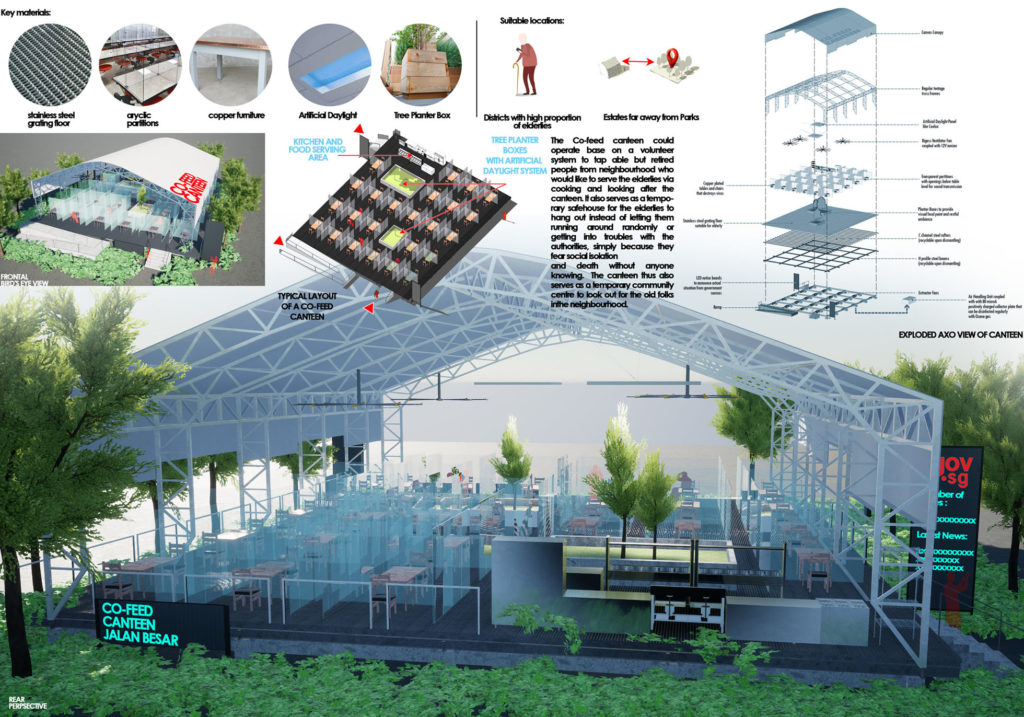
Design Challenge
#2: How might we encourage our community to support one another and look out for those who are socially isolated?
Project Description
The key proposal is to Design for the Mind in order to overcome the fear of Covid-19. Just like how Ex-American President Roosevelt sent his bombers in to Tokyo after Pearl Harbour was bombed to lift the morale and rally his citizens despite knowing that the mission was suicidal, the proposal seeks to share an audacious idea of a community canteen that is safe for the elderlies to enjoy a warm meal, to meet some familiar faces and to enjoy the fresh air despite the risks and the lack of vaccine. By the sheer audacity of the proposal, even without actually building it, I hope the information is enough to let us bear hope that we could as a society trumps over the fear of the unseen enemies.
Criteria #1: Value
The proposals aim to address the fear Covid-19 has for our elderlies. It is in fact a series of measures to help alleviate the fear for the social isolated, especially the elderlies, who have being kept away from face-to-face socializing; the uncertainty of the news due to the the lack of tech knowledge or support; the uncertainty of lonely death unknown to others due to Circuit Breaker segregation. While younger generation can seek solace via internet and social media, the elderlies lack the know-how or means which makes it very important for them to hang out physically in parks or coffeeshops or obtain information via less complicated means, which my proposal is hoping to address. The proposal could also have symbolic meaning in our fight with Covid-19.
Criteria #2: Inspiration
The key proposal – the Co-feed canteen seeks to turn the fear away from getting outdoors for the elderlies via ideas taken from scientifically proven researches that could greatly reduces the chance of being infected by Covid -19. It also provides a monitored secure venue that could also reduce the chances of elderlies hanging out randomly and breaching the Circuit Breaker laws due to their need to be outdoors, which we could observe to be quite common since the beginning of CB. This in turn reduce their risks of them being infected in unknown places. The walkie-talkie buddies concept also helps to resolve the problems the elderlies have with modern communication devices.
Criteria #3: Impact
The vaccine wont be available till a year later. It would be difficult and unimaginable to keep the elderlies at home till the vaccine is developed. As such, it might be better for institutes to take technologies proven to curb infections to be used in specific outdoor venues catered to the most needy in the society, which could in turn better protect them. Just as how China used the construction feat of Huo Shen Shan Hospital and Lei Shen Shan Hospital as a beacon to keep the spirits of its people up, a Co-feed community canteen for the elderlies could be Singapore’s beacon in symbolizing our resilience and fortitude in our determination to overcome the fear of Covid-19 and doing the unimaginable : to create a social venue for the group with the weakest immunity through advanced science.
Criteria #4: Timeliness
If China could build 2 hospitals in 2 weeks, we could probably build at least 1 canteen in 2 weeks with the right resources available since it is predominately using recyclable tentage structure as the frame . Designing jackets for the walkie talkies and the User interface for the LED announcement boards could be tested and implemented between 3 to 6 months too.
Criteria #5: Systems Thinking
Having a community canteen allows the elderlies to dine in place at a government subsidised rate , get monitored for health issues and be taken care for by the neighbourhood staff on duties while significantly reduce the needs to use food packaging, hence more environmentally friendly. Unlike old folks home, which largely hide the plights of the old folks from public concern, a Co-feed canteen could help to create more awareness of these elderlies in our neighbourhood and hence in return, potentially creating stronger social cohesiveness and empathy through greater awareness of their conditions.


